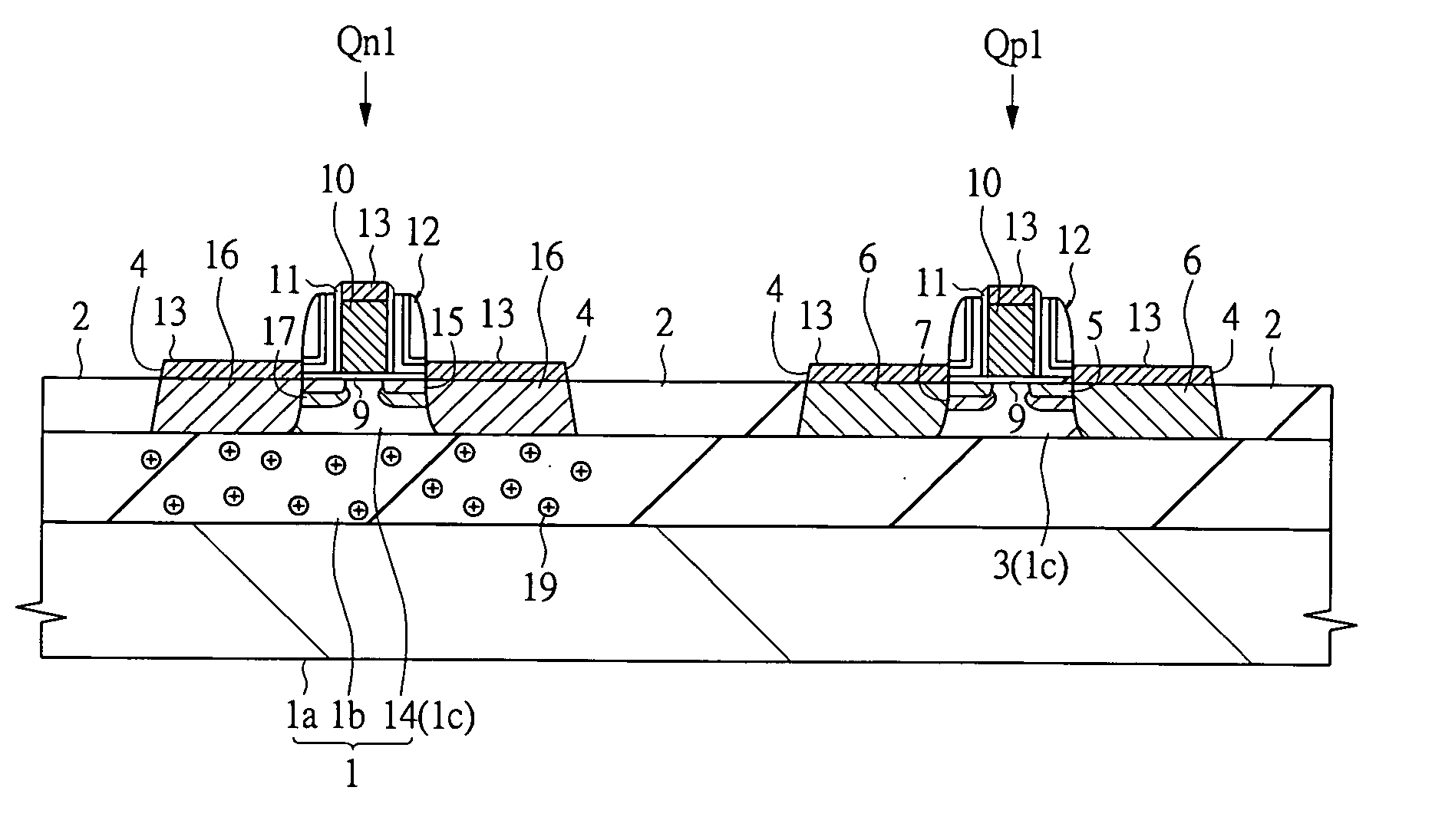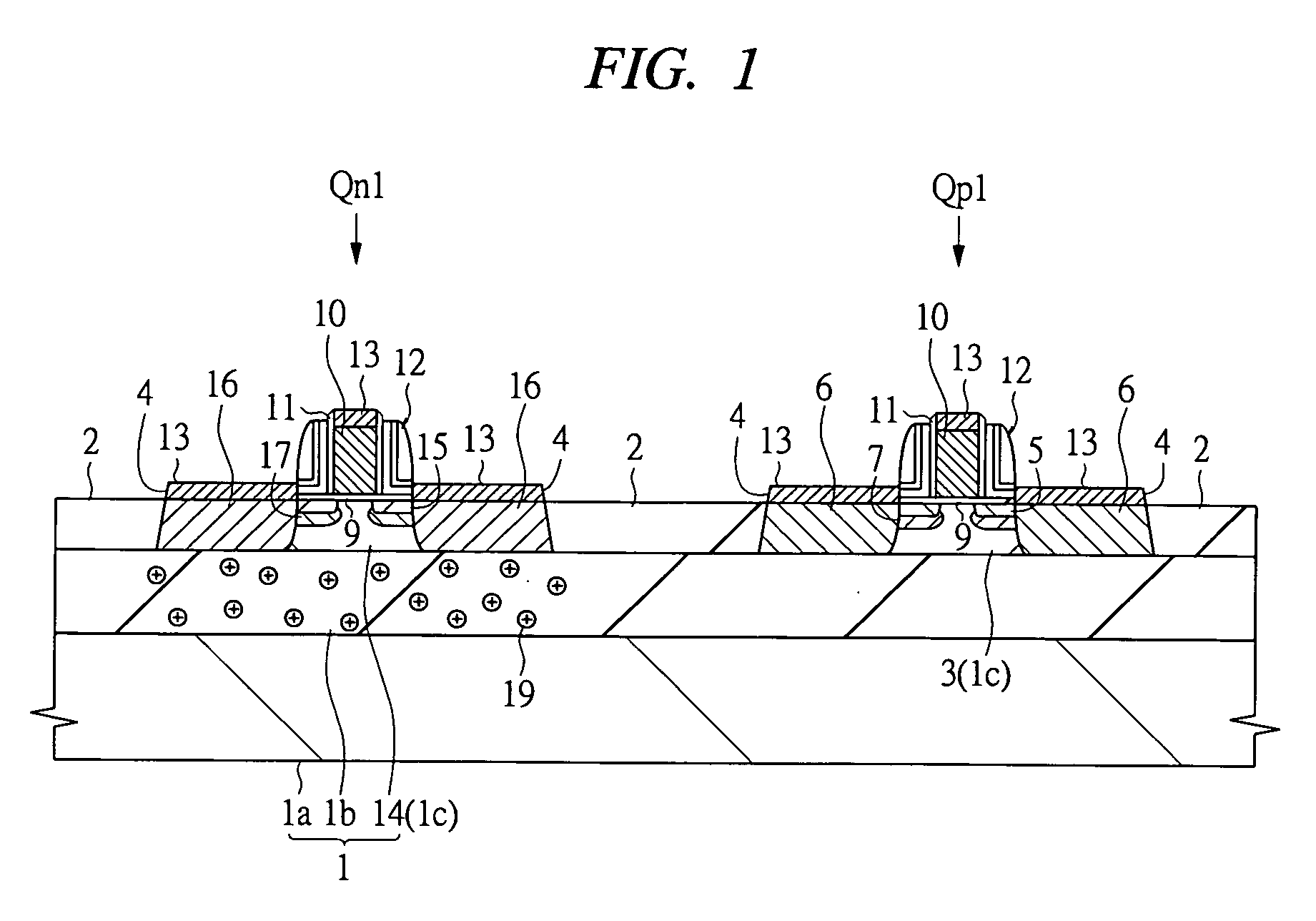Semiconductor device and manufacturing method thereof
a technology of semiconductor devices and semiconductors, applied in semiconductor devices, electrical devices, transistors, etc., can solve the problems of complex gate material selection, inability to relatively increase the impurity concentration of the channel region, and the full-depletion type of soi devices
- Summary
- Abstract
- Description
- Claims
- Application Information
AI Technical Summary
Benefits of technology
Problems solved by technology
Method used
Image
Examples
first embodiment
[0062]FIG. 1 is a sectional view of a principal portion of a SOI substrate showing a full-depletion type SOI device according to a first embodiment. A CMOS device is illustrated as the full-depletion type SOI device and the reference symbol “Qp1” is a pMIS and “Qn1” is an nMIS in FIG. 1.
[0063] The pMIS Qp1 and nMIS Qn1 are formed on a SOI substrate 1 manufactured by, for example, a SIMOX (Separation by Implanted Oxygen) method. The SOI substrate 1 is constituted so that a SOI layer (or body layer) 1c is formed on a supporting substrate la through a BOX (Buried Oxide) layer 1b. The BOX layer 1b is made of an insulating material having a thickness of, for example, approximately 100 nm and the SOI layer 1c is made of single crystal silicon having a thickness of, for example, 50 nm or less.
[0064] The pMIS Qp1 is formed on the SOI layer 1c and is formed in an n-type well 3 surrounded by device isolation 2. A silicon layer 4 is stacked on the n-type well 3 by a selective epitaxial growt...
second embodiment
[0090] In the above-described first embodiment, the material having a work function approximate to that of the channel region of the pMIS Qp1, such as molybdenum or ruthenium, is used as a gate material of each gate electrode 10 of the pMIS Qp1 and nMIS Qn1 to control the threshold voltage of the pMIS Qp1, and the threshold voltage of the nMIS Qn1 is controlled by the positive fixed charges 19 induced in the BOX layer 1b under the p-type well 14. However, in this second embodiment, a material having a work function approximate to that of the channel region of the nMIS, such as platinum (Pt) or lead (Pb), is used as a gate material of each of the PMIS and nMIS to control the threshold voltage of the nMIS, and the threshold voltage of the pMIS is controlled by negative fixed charges induced in the BOX layer.
[0091] The second embodiment will be described with reference to FIG. 16. FIG. 16 is a sectional view of a principal portion of a SOI substrate showing a full-depletion type SOI d...
third embodiment
[0094]FIG. 18 is a sectional view of a principal portion of a SOI substrate showing a full-depletion type SOI device according to a third embodiment. A CMOS device is illustrated as the full-depletion type SOI device. A pMIS Qp3 and an nMIS Qn3 have relatively high threshold voltages and a pMIS Qp4 and an nMIS Qn4 have relatively low threshold voltages. Note that the third embodiment, excluding the constitution of the gate electrode and the fixed charges induced in the BOX layer, is identical to the first embodiment and therefore the explanation thereof will be omitted.
[0095] Two pMISs Qp3 and Qp4 and two nMISs Qn3 and Qn4 are formed on the SOI substrate 1. Materials having work functions approximate to those of channel regions of the pMISs Qp3 and Qp4, such as molybdenum or ruthenium, are used as gate materials of gate electrodes 27p of the pMISs Qp3 and Qp4. Since positive fixed charges are induced in the BOX layer 1b under an n-type well 28 in which the pMIS Qp3 is formed, the p...
PUM
 Login to View More
Login to View More Abstract
Description
Claims
Application Information
 Login to View More
Login to View More - R&D
- Intellectual Property
- Life Sciences
- Materials
- Tech Scout
- Unparalleled Data Quality
- Higher Quality Content
- 60% Fewer Hallucinations
Browse by: Latest US Patents, China's latest patents, Technical Efficacy Thesaurus, Application Domain, Technology Topic, Popular Technical Reports.
© 2025 PatSnap. All rights reserved.Legal|Privacy policy|Modern Slavery Act Transparency Statement|Sitemap|About US| Contact US: help@patsnap.com



